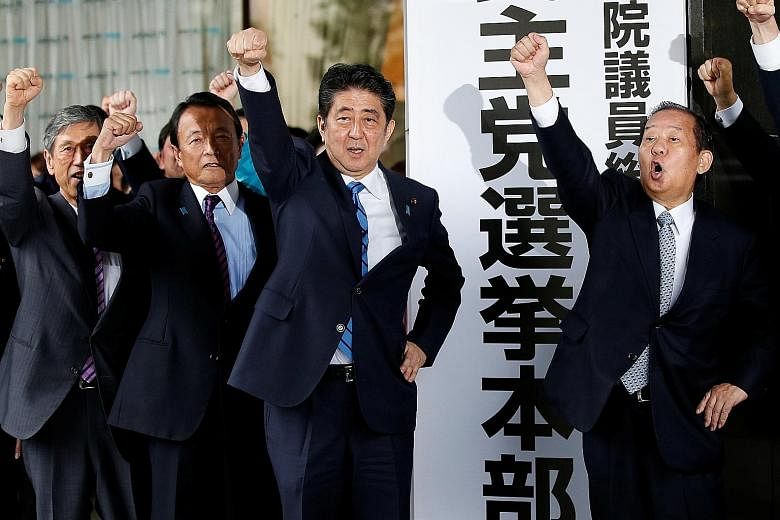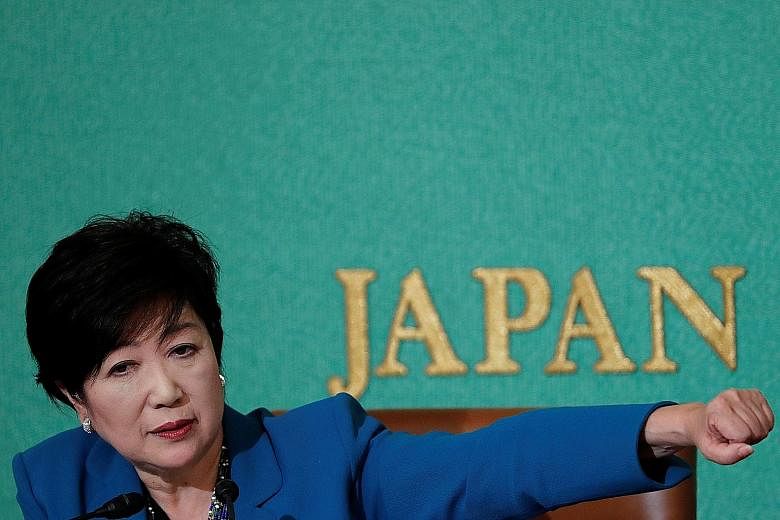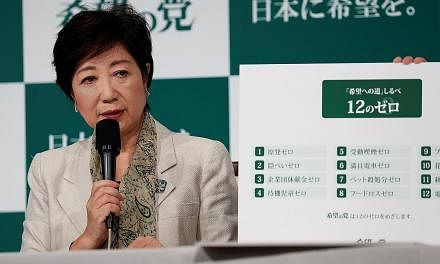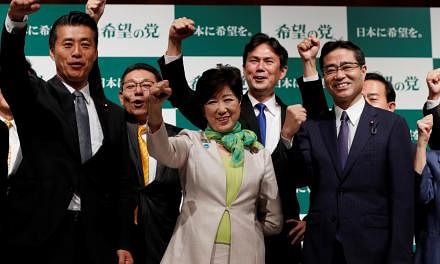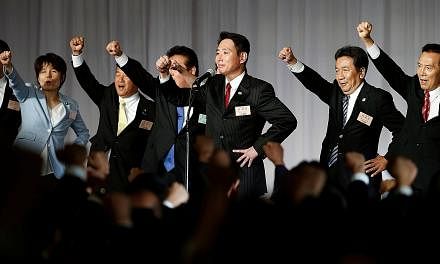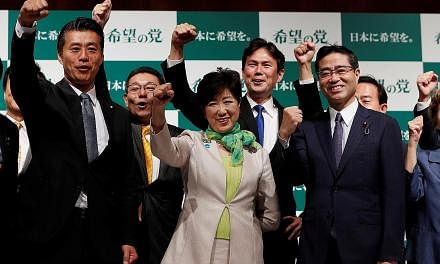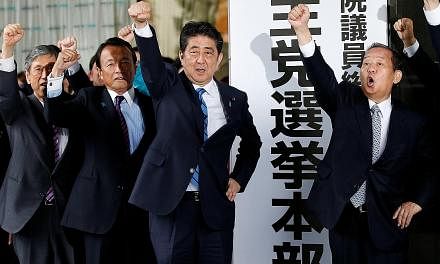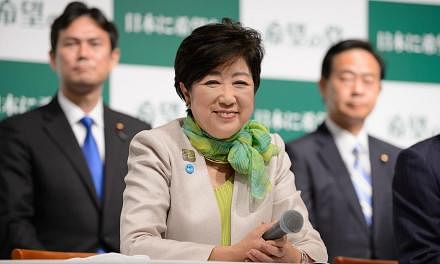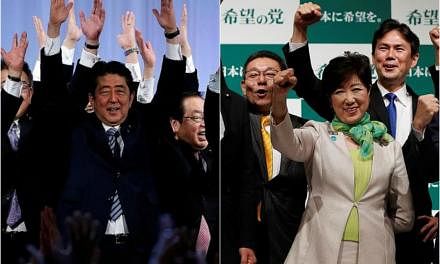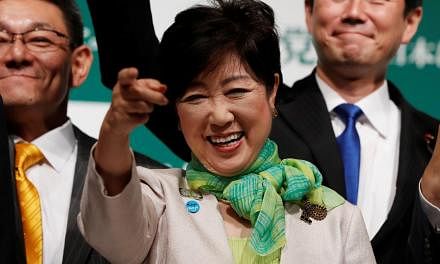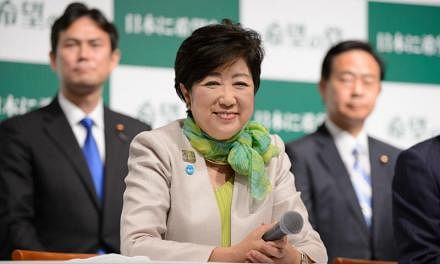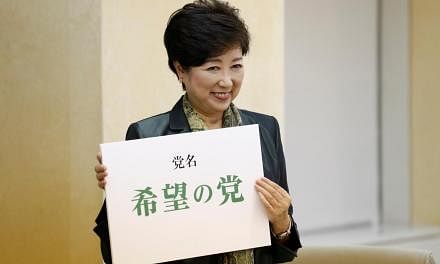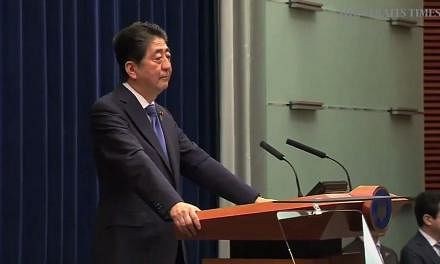With three shouts of "banzai", the starting pistol for the race to form Japan's next government was fired yesterday as its Parliament was dissolved for a snap election on Oct 22.
Members of the Lower House raised their arms and shouted the cheers after a letter officially dissolving the chamber was read.
Campaigning will start on Oct 10, with 465 seats up for grabs.
Opposition groups, including the Democratic Party (DP), which was in power from 2009 to 2012, are rallying behind the new Kibo No To (Party of Hope) led by Tokyo Governor Yuriko Koike to challenge the ruling Liberal Democratic Party (LDP).
DP chief Seiji Maehara said yesterday that the party will not field any candidates, and called on members to run under the Kibo No To banner.
"We have to discard our name for our vision of an ideal society to bear fruit," Mr Maehara said yesterday, alluding to the party's reputation of disunity and bungling. "No matter how good the product is, it is no use if it can't find a buyer."
The alliance was immediately slammed by Prime Minister Shinzo Abe of the LDP : "Hope can never be born from parties that merely change their signboard for the sake of a poll."
The ruling party's politicians took potshots yesterday at Ms Koike, a former LDP politician who ran successfully for Tokyo Governor. She quit the party this year, and is seen as a potent threat as she has twice taken on Mr Abe's LDP - and won.
Popular LDP politician Shinjiro Koizumi, son of former prime minister Junichiro Koizumi, yesterday threw down the gauntlet for Ms Koike to run as a candidate.
The younger Koizumi said sarcastically: "Instead of wearing a sports shoe and a high heel concurrently, why not come out just wearing one type of footwear?"
Ms Koike is not running in the Lower House elections - she has previously said she would go into the battle as Tokyo Governor and as leader of the Kibo No To, without running for a seat. The party wants to field at least 100 candidates.
Media polls yesterday showed Ms Koike's party having already gained some traction.
A survey by the Mainichi daily said 18 per cent of respondents intended to vote for Kibo No To, compared with 29 per cent for the LDP. The Asahi daily pegged it as 13 per cent for Kibo No To, and 32 per cent for the LDP.
Ms Koike, 65, has styled herself as a maverick politician who is the voice of reform and a warrior against old-school politics.
The nascent Kibo No To has not spelt out a clear policy platform, although it has said it wants to delay the tax hike until Japan's economy gains momentum.
In calling for a snap election 14 months before it was due, Mr Abe said he had found it necessary to go to the people for their approval on how he intends to spend additional revenue from a tax hike slated to begin in October 2019.
"A difficult battle starts today," Mr Abe told reporters yesterday.
"This is an election about how to protect the lives of people," he said.
"We have to cooperate with the international community as we face the threat from North Korea," he added, saying that he needs a mandate on his leadership amid the North Korean crisis.
The LDP had controlled two-thirds of the Lower House with its coalition partner Komeito.
Mr Abe is two years away from becoming Japan's longest-serving leader. He was expected to cruise to victory despite a ratings slump this year over two cronyism scandals, until Ms Koike's surprise return to national politics.
Mr Abe said yesterday: "It is going to be a very tough fight, but this will be an election that is centred on the questions of how to protect Japan today from external threats, and safeguard its future amid the demographic issues of a low birth rate and an ageing population."
How the elections work
• Two Houses form the bicameral parliamentary system - the Lower House (House of Representatives) and the Upper House (House of Councillors). The Lower House is the more powerful as it is responsible for tabling laws.
• Separate polls are held for the Lower House and the 242-seat Upper House.
• Lower House lawmakers have a term of four years. The chamber can be dissolved at the discretion of the prime minister for an election.
• Upper House lawmakers have a term of six years. Elections are held every three years to elect half of the lawmakers as their terms expire. The chamber cannot be dissolved.
• The Lower House elections combine the "first-past-the-post" system and the "party list" proportional representation system.
• Of the 465 seats up for grabs, 289 lawmakers are to be elected under the first-past-the-post system. The other 176 will enter Parliament, or the Diet, via the party list.
• Japan is divided into 289 single-member districts and 11 regions for the Lower House election.
• Voters get two ballots: To select their preferred party in their district, and their preferred candidate in their region. (a) First-past-the-post: The elected lawmaker will be the candidate who wins the most number of votes in each district. (b) Party list: Each political party draws up a list - in preferential order - of lawmakers for the party list. For example, if the Liberal Democratic Party (LDP) wins 50 per cent of the party-list vote in a region, it will get 50 per cent of the region's assigned number of seats. The lawmakers who get to enter the Diet will be based on the party list. So, if the LDP wins 10 party-list seats in Tokyo, the first 10 lawmakers on its list will enter the Diet.
• Lawmakers can both run for a single seat and be assigned to the party list. This means they can still enter the Diet through the proportional representation system, even if they fail to win the most votes in their constituency.
